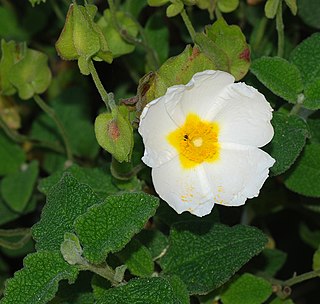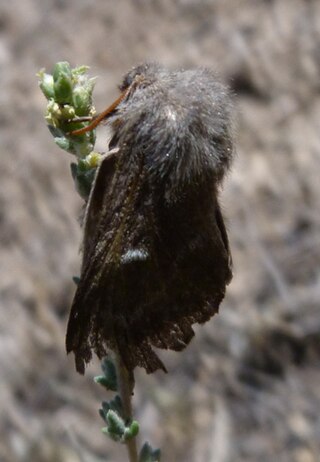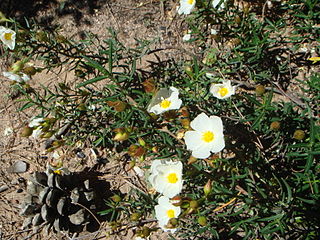
The Cistaceae are a small family of plants known for their beautiful shrubs, which are profusely covered by flowers at the time of blossom. This family consists of about 170(-200) species in nine genera that are not very distinct, distributed primarily in the temperate areas of Europe and the Mediterranean basin, but also found in North America; a limited number of species are found in South America. Most Cistaceae are subshrubs and low shrubs, and some are herbaceous. They prefer dry and sunny habitats. Cistaceae grow well on poor soils, and many of them are cultivated in gardens.

Cistus is a genus of flowering plants in the rockrose family Cistaceae, containing about 20 species. They are perennial shrubs found on dry or rocky soils throughout the Mediterranean region, from Morocco and Portugal through to the Middle East, and also on the Canary Islands.

Lactarius is a genus of mushroom-producing, ectomycorrhizal fungi, containing several edible species. The species of the genus, commonly known as milk-caps, are characterized by the milky fluid ("latex") they exude when cut or damaged. Like the closely related genus Russula, their flesh has a distinctive brittle consistency. It is a large genus with over 500 known species, mainly distributed in the Northern hemisphere. Recently, the genus Lactifluus has been separated from Lactarius based on molecular phylogenetic evidence.

Cistus ladanifer is a species of flowering plant in the family Cistaceae. It is native to the western Mediterranean region. Common names include gum rockrose, labdanum, common gum cistus, and brown-eyed rockrose.

Cistus salviifolius, common names sage-leaved rock-rose, salvia cistus or Gallipoli rose, is a shrub of the family Cistaceae.

Cytinus is a genus of parasitic flowering plants. Species in this genus do not produce chlorophyll, but rely fully on its host plant. Cytinus usually parasitizes Cistus and Halimium, two genera of plants in the family Cistaceae. It has also been found on Ptilostemon chamaepeuce.

Cistus monspeliensis is a species of rockrose known by the common name Montpellier cistus. It is native to southern Europe and northern Africa, in the Mediterranean forests, woodlands, and scrub ecosystems of matorral—maquis shrublands.

Ophiusa tirhaca, the green drab, is a moth of the family Erebidae. The species was first described by Pieter Cramer in 1777. It is found in southern Europe, Africa, Australia and the southern parts of Asia.

Psilogaster is a monotypic moth genus in the family Lasiocampidae first described by Reichenbach in 1817. Its only species, Psilogaster loti, described by Ferdinand Ochsenheimer in 1810, is found in south-western Europe and North Africa.

Grammodes congenita is a moth of the family Noctuidae. It is found in Africa, including South Africa, Eswatini and Madagascar.
Auctorum indicates that a name in botany and zoology is used in the sense of subsequent authors, and not in the sense as established by the original author. Its etymology derives from the Latin word for of authors, and is abbreviated auct. or auctt.

Cistus laurifolius, commonly called laurel-leaf cistus, laurel-leaved cistus or laurel-leaved rock rose, is a species of highly branched flowering evergreen shrub native to some areas around the Mediterranean.

Halimium ocymoides, the basil-leaved rock rose, is a species of flowering plant in the family Cistaceae, native to Portugal and Spain in the Iberian Peninsula, and northern Morocco in Northwest Africa. It is an erect evergreen shrub growing to 60 cm (24 in) tall by 100 cm (3 ft) wide, with woolly grey-green leaves and bright yellow flowers in spring. The flowers may have a dark brown blotch at the base of each petal.

Cistus albidus, the grey-leaved cistus, is a shrubby species of flowering plant in the family Cistaceae, with pink to purple flowers, native to south-western Europe and western north Africa.

Cistus clusii is a shrubby species of flowering plant in the family Cistaceae, with white flowers, native to south west and south central Europe and north Africa. It has been wrongly called Cistus libanotis by many authors.

Cistus crispus is a shrubby species of flowering plant in the family Cistaceae, with pink to purple flowers, native to south-western Europe and western north Africa.

Cistus heterophyllus is a shrubby species of flowering plant in the family Cistaceae.
Cistus inflatus is a shrubby species of flowering plant in the family Cistaceae, often known as Cistus psilosepalus, although this name is a synonym of the hybrid Cistus × laxus. It has white flowers.

Cistus libanotis is a shrubby species of flowering plant in the family Cistaceae, with white flowers. It has been confused with Cistus clusii, which it resembles, resulting in some uncertainty in its distribution. It is endemic to the Iberian Peninsula.

Cistus munbyi is a shrubby species of flowering plant in the family Cistaceae, with white flowers. Related to and resembling Cistus clusii, it is native to Morocco and Algeria in western north Africa.


















